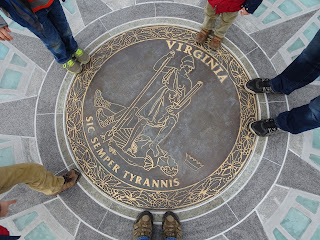On the
checklist during our coastal-Virginia trip: visit Jamestown, the capitol of the Virginia colony which was established in 1607. Sounds simple, but not only
is Jamestown also spelled Jamestowne (complicating searches), but it is actually a part of
the Colonial National Historical Park (along with Yorktown and the Colonial Parkway) and is located within spitting distance of several other ‘historical parks.' We
first pulled into ‘Jamestown’ only to discover it wasn’t the actual location of the former Jamestowne settlement, but a separate park administered by the Commonwealth of Virginia. Although it features a museum, full-size replicas of the three ships that brought the
settlers, a reconstructed fort and Powhatan village (and charges an additional
fee), the ‘real’ Jamestown is another mile down the road – follow the Park
Service signs!
 |
| The Tercentenary Monument commemorates Jamestowne's 300th anniversary |
Once
we determined that we had arrived at the correct destination, we started our
explorations at the Visitor Center. After paying the admission fee (which also
covers the National Park Service-managed Yorktown) and picking up Junior Ranger
booklets, we headed across the footbridge to join a tour. Jamestown is split
into two distinct sections: Old Towne and New Towne. While New Towne is managed
by the National Park Service and features replicas of the excavations of several
residences, warehouses and workshops, Old Towne is under the purview of
Preservation Virginia and contains the site of the 1607 James Fort, the remains
of the 1600s Church Tower and the 1907 Memorial Church.
 |
| Visible: 1600s church tower with 1907 church behind it |
The
site was selected with defense in mind, the location on the James River separated
from the mainland by large expanses of swamp. The colonists assumed they would
have to defend their settlement against the Spaniards who would be coming
across the water. In fact, the swamp was easily traversed by the Natives, and
the exposed position meant it was harder to secure drinking water and grow
crops. Only 60 of the 300 colonists survived the “starving time” (the winter of
1609-1610), but as ships continued arriving over the next ten years (supplementing
the population), and the Powhatan tribe lent their assistance, the colony was
preserved – despite disease, malnutrition, poor leadership, the unhealthy environment
and the worst drought in 800 years.
 |
| Inside the 1907 church |
Our
tour led us from the Tercentenary Monument to the Pocahontas Statue, the
Memorial Church (with the Historic Tower) and finally to the John Smith Statue
and the excavations of the 1607 James Fort. Our tour guide was absolutely
unbeatable, with an encyclopedia of knowledge on every applicable subject. We
learned about the modern-day excavations and all that's been learned from the
findings, peppered with interesting anecdotes and legends about those early days of the
settlement. Jamestowne came to life under our guide's vivid descriptions, and I’m extremely
grateful for all that we learned during our tour – despite the frigid weather!
 |
| Standing in the exact spot where Pocahontas and John Rolfe were married in 1614 |
Afterwards
we headed to the Voorhees Archaearium Archaeology Museum to warm up and view
the artifacts that tell the story of the James Fort. It’s absolutely amazing
what has been learned from the bones, weapons, bricks and detritus of the lives
of these early settlers! Roberts could have stayed in the Museum for hours…
 |
| Reconstruction of foundations of Fort's church, Smith statue in background overlooking James River |
The
Island Drive departs from the Visitor Center, a three or five mile loop that
takes visitors on a drive through the natural environment that the settlers
would have encountered. At the far end of the 5-mile loop is a short walking
trail to Black Point with views out to the east. Meanwhile just inside the Park
entrance is the Glasshouse, where artisans demonstrate glassblowing techniques
of the early 1600s. Glassblowing was one of Virginia’s first industries,
although easily surpassed by tobacco – the product that would underpin the colony’s
economic future.
It was
tobacco that determined the growth of Jamestown from precarious outpost to colonial
port and administrative center, tens of millions of people arriving on these
shores in the next 300 years to start their lives anew. Figures from our
history books - Pocahontas, John Smith, John Rolfe – these people traversed the
same land that we were so casually visiting. Although we have seen much older historical
sites during our time in France, the 400 year-old Jamestown is one that has
directly impacted our lives. Had it not been for these initial European
settlers on the shores of the James River, it is very unlikely that my
grandparents would have arrived on American soil – 300 years later. Funny
enough, the thoughts that were in my head as we pulled back onto the Colonial
Parkway en route to Yorktown were not so deep; instead I was wondering who in
their right mind starts a colony on such low ground next to a swamp…



















































